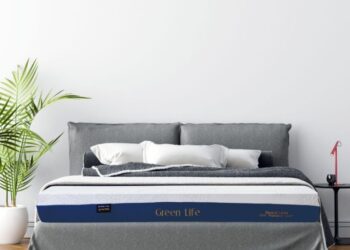The Apple Watch has been our longstanding Editors’ Choice for its excellent performance, unparalleled app selection, and ample health and fitness tracking features. With the Series 6 (starting at $399), Apple builds upon its flagship smartwatch with the addition of a blood oxygen saturation sensor that calculates your SpO2 level on demand and captures periodic background measurements when you’re sleeping and inactive. Putting this technology in a consumer wearable has never been more important given the global COVID-19 pandemic, as it indicates how well your circulatory and respiratory systems are delivering oxygenated blood to your body, and can help you gauge whether a hospital visit is necessary.
Beyond this, Apple’s changes include a faster processor, an always-on altimeter that lets you see your elevation in real time, and a bump in screen brightness when your wrist is down. These improvements, plus many new additions in watchOS 7, including a 20-second handwashing timer and sleep-tracking capabilities, make the Apple Watch Series 6 the company’s best smartwatch yet, and our new Editors’ Choice.
Pricing
Apple introduced two new smartwatches this year—the flagship Series 6 and the more affordable Watch SE. The Series 6 starts at $399 for the GPS-only model and $100 more for the GPS and cellular version.
The Watch SE, which shares design elements with the Series 6, along with key health and safety features like fall detection, starts at $279 for the GPS-only model or $329 for the GPS and cellular version. It lacks an always-on display, as well as blood oxygen saturation and electrocardiogram (ECG) readings—we go into detail on the differences between the two watches here.
The GPS-only Series 3 remains on sale for just $199 as another budget-friendly option. All models require a paired iPhone, so Android users are out of luck.
The Series 6 comes in 40mm and 44mm case sizes, and three different case materials: 100 percent recycled aluminum, polished stainless steel, or brushed titanium. Apple is also giving you some new jewel-toned colors to choose from this year.

The aluminum Series 6 is available in new navy blue and red hues, as well as gold, silver, and space gray. The stainless steel model comes in a new classic yellow gold tone, a grayish-black called graphite, and silver. The titanium model comes in natural titanium and space black.
Swapping out the strap is a big part of the Apple Watch experience for a lot of people, and this year Apple debuted some nice new options, including the $49 Solo Loop (which you can choose to get with the watch instead of the default Sport Loop) and the $99 Braided Solo Loop. Both feature no clasps, buckles, or overlapping parts, and are available in a range of colors. They stretch over your wrist and come in nine different sizes to ensure a good fit. The Solo Loop is made of liquid silicone rubber, while the Braided version is made of 100 percent post-consumer recycled yarn that is braided around a thin silicone thread.
For this review, I tested a 40mm GPS and cellular Series 6 with a blue aluminum case and a deep navy Sport Loop. Apple also sent a matching Atlantic Blue Braided Solo Loop(Opens in a new window) band in size 4, which fits perfectly on my wrist. Between the $499 watch and the extra $99 band, the total cost of the watch pictured below is $598.
The new Braided Solo Loop looks chic, yet understated and casual. It feels secure and is easy to get on and off, but its $99 price is hard to swallow. For the sake of comparison, the fancy Milanese Loop is also $99.
In the box with the watch, Apple includes a charging cable, but you don’t get a USB power adapter. Apple says it made this decision to help the environment, and it will have the same impact as eliminating 50,000 cars from the roads.
Design
Like it or not, the Series 6 has the distinctive squarish design with rounded corners the Apple Watch is known for. The 40mm model measures 1.56 by 1.35 by 0.42 inches (HWD), while the 44mm model is a touch taller and wider, but the same thickness, at 1.73 by 1.48 by 0.42 inches.
Looking at the Series 6 next to the Series 5, it’s hard to see a difference aside from the case color and band. Indeed, Apple hasn’t made any changes to the size or resolution of the display. To that end, the 40mm model has a 1.57-inch display with 394 by 324 pixels, while the 44mm Series 6 has a 1.73-inch display with 448 by 368 pixels.

The Series 6 is light and comfortable on my wrist, even when I wear it to bed. The 40mm and 44mm aluminum models weigh 1.07 ounces and 1.28 ounces, respectively, without the strap. The stainless steel models are the heaviest at 1.40 ounces and 1.66 ounces, and the titanium models weigh 1.22 ounces and 1.45 ounces.
The Series 6 is water-resistant to 165 feet. Apple says it’s safe for shallow water activities like swimming (in a pool or in the ocean). You can also wear it in the shower and hot tub. You shouldn’t, however, wear it while scuba diving, waterskiing, or “other activities involving high-velocity water or submersion below shallow depth,” Apple says.
Setup and Interface
The Series 6 comes partially charged, and as soon as you take it out of the box and turn it on, a screen will appear on your iPhone asking if you want to set the watch up for yourself or someone else using Apple’s new Family Setup service. It then instructs you to put on the watch, hold it up to your phone’s camera, and align the watch face with the viewfinder on screen to pair it. As soon as I did this, it said the Apple Watch was paired and asked me if I wanted to restore from a backup or set it up as a new watch. I regularly use the Series 5, so I chose to restore from that device.

You have the option to enable the Blood Oxygen app during the setup process, which lets you check your blood oxygen saturation (SpO2) levels and measure them throughout the day (you can also turn this feature on later). Next, you can optionally enable automatic updates; if you do, you’ll receive a notification before the update is installed. It then asks if you want to set up Apple Pay.
Next, it goes over the Emergency SOS and fall detection features. To call emergency services, press and hold the side button. Doing so will also send a message to your emergency contacts. With fall detection enabled, the watch will automatically call emergency services if it detects you took a hard fall. You can disable this feature in the Apple Watch app if you prefer.
If you have a cellular model, it then goes into the cellular setup process. With this feature, you can make and receive calls and access apps using cellular data when your Apple Watch isn’t connected to your iPhone. When you click Set Up Cellular, it brings up a new page that lets you sign in with your cell phone carrier and add the Apple Watch to your plan (which is typically an extra charge per month on your cellular bill). Next, it goes over watch faces, noting that you can change them later in the app or on the watch itself.

As with other Apple Watch models, you navigate the Series 6 with swipes to scroll and move, and taps to select. To see your notifications, swipe down from the top edge of the screen. To see your battery level and access additional controls like Do Not Disturb, swipe up from the bottom of the screen.
The Series 6 also features Apple’s signature digital crown on the top right side. Press this button to return to the watch face; press and hold it to talk to Siri; or turn it to scroll, zoom, or adjust.
Beneath the digital crown on the right side of the screen is a button with various functions. You can press it to quickly access your open apps; double-press it for Apple Pay; or press and hold it for Medical ID, Emergency SOS, and power.
Blood Oxygen Readings
The standout feature here is a new sensor that can measure the oxygen saturation of your blood, also known as SpO2. This metric indicates how well your circulatory and respiratory systems are delivering oxygenated blood to your body. Your SpO2 reading alone can’t diagnose COVID-19, but as the Yale School of Medicine advises(Opens in a new window), a reading below 90 percent may warrant a trip to the emergency room.
The Series 6 uses similar technology as a pulse oximeter—the device they clip onto your finger at the doctor’s office—to measure your blood oxygen saturation. Its SpO2 sensor shines red and infrared light through your skin, onto the blood vessels of your wrist, and measures the color of your blood, which indicates the amount of oxygen present. Bright red blood is more saturated, and dark red blood is less so. Changes in your body or elevation can impact your blood oxygen level.
The watch can calculate your SpO2 level in 15 seconds, whenever you want. The sensor also captures periodic background measurements when you’re sleeping and inactive.

The first time you open the Blood Oxygen app on the watch, it takes you through some helpful tips to get a good reading. Apple says your watch band should be snug but comfortable, and to make sure the watch isn’t too low on your wrist. You should keep the watch facing up and try not to move during the reading. Resting your arm on a table can help.
When you start a blood oxygen scan, you’ll see a 15-second countdown timer on the screen along with a relaxing blue and red graphic. After 15 seconds, your blood oxygen saturation percentage will appear onscreen. You can also view blood oxygen measurements in the Health app on your iPhone.
The watch offers information about this metric to help you interpret your data. It says that most people have a blood oxygen level between 95 and 100 percent. The first time I used this feature, the Series 6 said my blood oxygen saturation level was 99 percent. The second time I took a reading, it was after a three-mile beach run, and I was happy to see my SpO2 level was 100 percent.
In the Health app on your iPhone, you can view a record of all your measurements and see graphs of your blood oxygen level readings for the day, week, month, or year. It also shows your range and daily average, and you can filter the data to show just your SpO2 level in high-elevation environments or while sleeping.

This isn’t such a novel feature, as several other fitness trackers and smartwatches can measure your SpO2 level, including the Garmin Vivoactive 4, Samsung Galaxy Watch3, and Fitbit Sense. The Fitbit Sense, however, only measures your blood oxygen saturation level automatically when you wear it to bed, and you need a specific clock face enabled for it to work. It also takes a full two minutes.
Performance Improvements
On the inside, the Series 6 features 32GB of storage and Apple’s new dual-core S6 System in Package (SiP), which it says delivers up to 20 percent faster performance than the S5 chip in the Series 5 and Watch SE. The S6 also allows for improved screen brightness—the display still features a maximum brightness level of 1,000 nits, but it’s brighter in ambient mode when you look down at your wrist.
Apple says it increased the maximum brightness of the display from 200 nits to 500 nits when your wrist is down, which makes it easier to see in the sunlight. That’s a welcome addition for me personally, as I live in Florida and spend a lot of time at the beach. And I can attest that the Series 6’s screen is noticeably easier to read when I’m outside walking my dog and glance down.
The Series 6 also features a new antenna with double the spectrum of the Series 5 that enables it to support 5GHz Wi-Fi for the first time. This can help free up congested 2.4GHz bands, while allowing access to potentially speedier 5GHz bands.

According to Apple, the Series 6 offers the same 18-hour battery life as the Series 5, but drains less battery when streaming music and tracking certain workouts like indoor and outdoor runs. In testing, the watch surprisingly beat Apple’s estimate. After wearing it for a full 24 hours, it still had 14 percent battery left. During that time, I had the always-on display mode enabled and used the watch to track a 37-minute run with GPS. I also had Do Not Disturb on most of the time, so I wasn’t getting notifications, which could have extended battery life. After nearly 25.5 hours, I got a notification that the battery was down to 10 percent, so I finally put it on the charger.
The Samsung Galaxy Watch3 offered similar battery life in testing, but the Fitbit Sense lasted around three days.
One nice improvement is that the Series 6 charges faster than the Series 5, which takes around two hours to fully charge. The Series 6 charges to 80 percent in about an hour and to 100 percent in 90 minutes.
Always-On Altimeter
The Series 6 features an always-on altimeter, which makes it easy to check your elevation indoors and outdoors in real time (it’s also available on the lower-cost Watch SE). This feature is especially useful for hikers and downhill skiers.
The watch uses data from the barometric pressure sensor, GPS, and nearby Wi-Fi networks to determine your exact location and update your elevation on the fly. You can also add your elevation as a complication on the watch face.
I found this feature useful, even in flat Florida. I added the elevation complication to my watch face, and it was interesting to see it change in real time, especially as I approached the beach near my house, which in certain areas is below sea level, according to the Series 6.
I can see this feature being particularly useful during hurricane season, and in the future when I’m in the market for a new house. The Series 6 tells me my current home is around 35 feet above sea level, so if a hurricane is headed my way with a predicted storm surge greater than that, I’ll know to get out of town. When I start house hunting in the future, I’ll absolutely use the Apple Watch to check the elevation of prospective properties to make a more informed decision.
WatchOS7
The latest version of Apple’s smartwatch operating system, watchOS 7, offers a number of useful features, including automatic handwashing detection with a 20-second countdown timer, sleep tracking, new workout types (dancing, core training, cooldown, and functional strength training), and cycling directions in select cities (including Beijing, Los Angeles, New York, San Francisco Bay Area, and Shanghai). WatchOS 7 also features several new watch faces.
You don’t need the Series 6 to take advantage of these features. WatchOS 7 is also available on Apple’s Series 3, 4, and 5 watches, as well as the new Watch SE.

After testing the beta version of watchOS 7 on my Series 5 for more than a month, the handwashing countdown timer has become a necessity in my life, especially in light of COVID-19. The watch uses motion sensors to detect handwashing movements and the microphone to listen for the sound of running water. When it detects that you’re washing your hands, it displays a 20-second timer on the screen, so you don’t have to silently hum Happy Birthday twice in your head. When you’re done, the watch slightly vibrates and gives you a thumbs up on the screen.
I really like this feature, and when I’m testing other wearables, I miss it every time I wash my hands. I find that the countdown timer is sometimes accidentally triggered when I’m washing fruit and vegetables in the sink, but I just take it as a sign to wash again.
Apple is late to the game with sleep tracking capabilities, as most smartwatches and fitness trackers already offer this feature, and Apple’s version is still pretty basic. After you wear the Apple Watch to bed, the Health app on your iPhone shows when you fell asleep, woke up, and your total time in bed and asleep for the night. It also shows a graph of your heart rate, with your maximum and minimum recorded beats per minute. It charts your sleep for the week and month, and shows your average time in bed and average time asleep.

Many other wearables, including the $150 Fitbit Charge 4, track more stats like your deep, light, and REM sleep; offer graphs showing when you were asleep and awake throughout the night; and give you a sleep score that can help you quickly gauge the quality and restorative value of your shuteye. And if you plan to use the Apple Watch to track your sleep, you’ll likely need to modify your charging routine given its battery life. Instead of charging it at night, I recommend giving it a quick top-off in the morning when you’re getting ready for work, or at night when you’re getting ready for bed.
Another notable addition to watchOS 7 is Family Setup, a feature that lets you use your own iPhone to set up an Apple Watch for your child or another family member. Parents can use Family Setup to approve the contacts with whom their child can communicate. The service also offers automatic location notifications, so you can, for instance, receive an alert when your child gets home from school. The user you’re setting it up for will have their own account and phone number through a separate cellular plan (the feature is only available on cellular watch models).
Additional Health Features
The Series 6 has all the excellent health, safety, and lifestyle features of its predecessor. These include ECG readings, high and low heart rate notifications, irregular heart rhythm notifications, menstrual cycle tracking, fall detection, high decibel alerts, emergency SOS, and international emergency calling. The watch’s Move, Exercise, and Stand rings are a personal favorite, as they help motivate me to stay active on a regular basis and cheer me on when I do.

Before the end of the year, Apple plans to launch Fitness+, a $9.99 monthly or $79.99 yearly at-home fitness service. Fitness+, which will require an Apple Watch Series 3 or later paired with an iPhone, promises to bring a range of workouts led by world-class trainers to the comfort and safety of your home. When streaming a Fitness+ workout on your iPhone or iPad, metrics from your Apple Watch, including your exercise duration, heart rate, and calories burned, as well as your Activity Rings, will appear on the screen.
Later this year, Apple also plans to add a Low Cardio Fitness feature, which can notify you if your VO2 Max (a metric used to measure cardiovascular fitness indicating the maximum amount of oxygen your body can use during intense exercise) falls into a low range.
Apps
Additional Apple Watch features I find useful include Apple Pay for contactless payments, Siri language translations, and the overall calling and texting experience, including the ability to dictate text replies and view images in texts on the watch’s screen.
Perhaps the watch’s biggest strength remains the App Store, which lets you browse and install apps right on the watch itself. With more than 20,000 Apple Watch apps available, it easily has the largest, highest-quality third-party selection of any wearable.

In addition to downloading apps and swapping out the band, changing your watch face is a fun way to customize your device, and Apple has some new options to pick from. WatchOS 7 includes 7 new watch faces: GMT, which shows multiple time zones at once; Count Up, which lets you track elapsed time; Chronograph Pro, a stopwatch with a tachymeter speed-measuring tool; Typograph, which offers three custom type styles; Artist, which features a dynamic portrait created in collaboration with artist Geoff McFetridge; Memoji, featuring Apple’s animated characters; and Stripes; which can be customized based on what you’re wearing, your support for a cause, or your favorite sports team.
Comparisons and Conclusions
Since the Apple Watch made its debut five years ago, one of its primary functions has been to help you monitor your health. The Series 6 delivers two key features that build upon this greatly, and can help keep you safe in the age of COVID-19—an SpO2 sensor that lets you monitor your blood oxygen saturation level, and a countdown timer that keeps you honest when washing your hands. The Series 6 further impresses thanks to a faster processor, a brighter always-on display, and an improved altimeter that can track your elevation changes in real time.
It easily outperforms Google Wear OS-based watches like the Moto 360, and offers a much more fully realized smartwatch experience than Fitbit’s more health-centric models. If you already own a Series 5, the Series 6 is really only worth the upgrade if you absolutely must have the always-on altimeter or SpO2 readings. But between its advanced health and fitness monitoring capabilities, safety and lifestyle features, and wide selection of downloadable apps, the Apple Watch Series 6 is the best smartwatch on the market hands down, and our Editors’ Choice.
That said, if the $399 starting price is out of your budget, the new Apple Watch SE offers many of the same features as the Series 6—including a handwashing timer, sleep tracking, heart rate notifications, and more—for $120 less. It lacks an always-on display and some of the Series 6’s more advanced health features, however, including the ability to take an ECG and measure the oxygen saturation of your blood. It’s a strong alternative to the Series 6 if you don’t mind a less health-focused experience.






